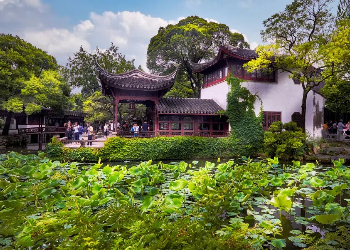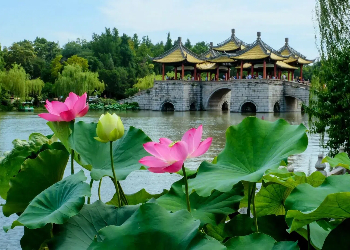Jiangsu is renowned for its profound historical heritage, abundant cultural relics, and stunning natural scenery. Below is a detailed Jiangsu travel guide, taking you on a journey to experience the unique charm of this province.
1、Journey of Historical Culture
Suzhou: Suzhou is famous for its exquisite classical gardens, long historical streets, and rich cultural heritage, representing a treasure of Chinese civilization. The garden art of Suzhou is universally recognized as a microcosm of “paradise on earth,” with gardens like Zhuozheng Garden and Lingering Garden serving as paradigms of garden art that attract numerous visitors from home and abroad. Zhuozheng Garden, one of the largest classical gardens in Suzhou, is renowned for its grand scale, ingenious layout, and rich cultural connotations. Lingering Garden, on the other hand, is famous for its delicate layout and profound cultural significance. The landscape, architectural style, and plant arrangement in the garden blend seamlessly, forming moving pictures. Besides garden art, the ancient city blocks of Suzhou are also full of charm. Shantang Street and Pingjiang Road historical blocks are the best representations of the ancient charm of Suzhou. Both streets have preserved buildings from the Ming and Qing dynasties, with quaint shops, teahouses, and residences scattered along the streets, making visitors feel like they have traveled back in time. Suzhou Museum is an important venue to understand Suzhou’s culture. Designed by renowned architect Ieoh Ming Pei, the museum is renowned for its unique architectural style and extensive exhibits. The museum’s exterior is simple and elegant, complementing the surrounding landscaped gardens.


Yangzhou: Yangzhou is renowned for its long history, rich culture, and unique natural scenery. Dongguan Ancient Ferry, as an important gateway to Yangzhou’s ancient city, has witnessed the historical changes of this city. Adjacent to Dongguan Ancient Ferry, Dongguan Street historical block is another excellent destination to experience the ancient cityscape of Yangzhou. This street has preserved a large number of buildings from the Ming and Qing dynasties, with quaint shops, teahouses, and residences scattered along the street, creating the atmosphere of a historic town. Besides the ancient cityscape, Yangzhou’s historical culture is also rich and diverse. Yangzhou Dual Museums (a museum of history and art) is an excellent place to understand the city’s historical culture. Tang City Site is one of the most famous sites in Yangzhou's history. It was once the bustling area of Tang-dynasty Yangzhou. Although only ruins remain today, the faintly visible city walls, gates, and palace foundations still allow people to imagine the glory and splendor of that era. Yangzhou, this city full of history and cultural heritage, captivates every visitor with its unique charm. Here, you can admire the ancient cityscape and flavor, deeply understand the city’s history and culture, taste authentic Yangzhou cuisine, and experience the warmth and hospitality of Yangzhou people.
2、Natural Scenery Journey
Taihu Lake: Taihu Lake, a dazzling pearl embedded in the east of China, is renowned for its vast waters, abundant ecological resources, and enchanting natural scenery. The beauty of Taihu Lake lies not only in its sparkling lake water but also in the picturesque scenery surrounding it, each spot captivating visitors so much that they forget to leave, as if immersed in a moving landscape painting. In the Taihu Lake area of Suzhou, you can take a boat tour to experience the tranquility and beauty of Taihu Lake up close. On the lake, the glinting waves merge seamlessly with the sky, making the whole world appear gentle and serene. As the boat glides slowly forward, you can see the lake water sparkling with golden light under the sunshine, as if countless dazzling gems are dancing. During the boat tour, you can also explore the historic sites and scenic spots hidden along the lakeside, such as the famous Yuantouzhu and Sanshan Island, to feel the weight of history and the charm of culture. These attractions are not only beautiful in scenery but also profound in cultural heritage, allowing visitors to delve into the history and culture of Taihu Lake while enjoying the scenery.


-
Slender West Lake: This dazzling pearl set on the land of Yangzhou is renowned for its unique garden landscape and charming lake scenery, making it a prominent representative of Jiangnan (south of the Yangtze River) garden art. It not only bears the profound historical and cultural heritage of Yangzhou but also attracts countless tourists with its exquisite layout, abundant landscapes, and unique charm. The beauty of Slender West Lake is first reflected in its unique garden landscape. Inside the park, meticulously designed pavilions, towers, bridges, and waterside pavilions blend beautifully with the lake scenery, forming a series of captivating scenes. Whether it’s the flower-adorned embankment in spring, the green-shaded lake surface in summer, the leaf-strewn path in autumn, or the snow-covered scenery in winter, Slender West Lake offers breathtaking views that change with the seasons, captivating visitors. Every spot is filled with poetic and picturesque charm, making people feel as if they are in a secluded paradise far away from the hustle and bustle of the world. The lake scenery of Slender West Lake is its greatest charm. As you stroll along the lakeside, you can feel the tranquility and beauty, as if engaging in a soulful conversation with nature.
Jiangsu is undoubtedly a treasure trove of culinary delights, with its rich food culture leaving visitors yearning for more. On this enchanting land, every city interprets the essence of Jiangsu cuisine through its unique dishes.
Nanjing, this historic ancient capital, boasts not only profound cultural heritage but also a distinctive presence in the realm of cuisine. Nanjing’s Salt-Water Duck, as an iconic delicacy of Jiangsu, is renowned nationwide for its thin skin, tender meat, delicious taste, and unique flavor. Its production process is meticulous, using high-quality duck meat that, after careful marination and a unique cooking technique, retains its original freshness while infusing the richness of saltwater, making every bite memorable.
Wuxi: This representative city of the Jiangnan water towns also attracts countless food lovers with its unique culinary culture. Wuxi’s soup dumplings, as a traditional local specialty, are known for their paper-thin skin and rich, flavorful soup. Gently biting into the delicate, cicada-wing thin dough, a burst of rich soup instantly floods the mouth, followed by the tender meat filling. The perfect combination of the two creates an unparalleled delicious experience.


-
Zhenjiang, a city located on the south bank of the Yangtze River, also boasts mouthwatering cuisine. Zhenjiang’s “Gaitan Noodles,” favored by diners for their unique production process and delicious soup base, are characterized by their chewy and smooth noodles, rich and savory broth, and carefully selected ingredients. Each bowl of Gaitan Noodles exudes an enticing aroma, making it irresistible to those who taste it.
4、Festival Culture Experience
Diving into Jiangsu, you will embark on a vibrant and colorful journey of festival culture experiences. The traditional festival culture here not only boasts a long history but also displays distinct regional characteristics. Each celebration unfolds like a vivid cultural painting, showcasing Jiangsu’s profound cultural heritage and the people’s love and preservation of traditional culture.
Suzhou’s Dragon Boat Festival customs, designated as a national intangible cultural heritage, are a dazzling gem in Jiangsu’s festival culture. On this day, the streets and alleys of Suzhou are filled with the fragrance of mugwort, and every household hangs calamus. Traditional activities such as dragon boat races, eating zongzi (glutinous rice wrapped in bamboo leaves), and hanging sachets are held to commemorate the great patriotic poet Qu Yuan. These customs also carry people's good wishes for health and safety. They are not only a remembrance of history but also a lively transmission of traditional culture.
Nanjing’s Qinhuai River Lantern Festival is another breathtaking national intangible cultural heritage. During the Spring Festival each year, the banks of the Qinhuai River transform into a sea of lights. Various lanterns, dazzling and diverse in shape, range from traditional designs depicting auspicious dragons and phoenixes or blooming lotuses to modern creative incorporations, immersing visitors in a dreamlike world. During the lantern festival, people enjoy lanterns, guess riddles, release river lanterns, and make wishes, celebrating the arrival of the new year and feeling the rich festive atmosphere and unique charm of Qinhuai culture.


-
Jiangyan Qintong Boat Gathering is a splendid exhibition of Jiangsu’s water town culture, also listed as a national intangible cultural heritage. Around the Qingming Festival each year, a grand aquatic celebration unfolds at Qintong Lake in Jiangyan. Hundreds of gorgeously decorated boats gather, engaging in rowing competitions, water performances, and other activities. The scene is spectacular and lively. This custom not only showcases the diligence and wisdom of the people in Jiangsu’s water towns but also reflects their awe of nature and love for life.
5、Exploring the Mysteries of Ancient Sites
Venturing into the vast expanse of Jiangsu, you will embark on an archaeological adventure through time. Each archaeological site park here is like a heavy historical tome, guiding us through thousands of years to explore the historical context and cultural heritage of this land.
The Two Tombs of the Southern Tang Dynasty, as important archaeological sites from the Sui, Tang, and Five Dynasties periods, lie quietly on the land of Jiangsu, recounting the turbulent history of that era. These two tombs are not only the resting places of the last emperor of the Southern Tang Dynasty, Li Yu, and his family but also invaluable physical materials for studying the history, culture, art, and even the ancient Chinese tomb system of the Southern Tang Dynasty. The exquisite artifacts unearthed from the tombs, such as murals, porcelain, gold and silver vessels, not only demonstrate the superb craftsmanship of the Southern Tang period but also reflect the prosperity of society at that time, providing important clues for us to understand the politics, economy, and culture of that era.
The Ming Imperial Palace Site is another significant landmark in Jiangsu and even Chinese history during the Song, Yuan, Ming, and Qing dynasties. As the location of the imperial palace in the early Ming Dynasty, the Ming Imperial Palace was a model of ancient Chinese palatial architecture, featuring a grand scale and rigorous layout that embodied the essence of ancient Chinese architectural art. Although it has undergone numerous vicissitudes, only partial ruins remain today. However, those broken walls and stone bases carved with dragons still convey the majesty and splendor of the royal family of that time. The Ming Imperial Palace Site is not only an important physical material for studying ancient Chinese palatial architecture and court life but also a crucial window for exploring the political, economic, and cultural development of the Ming Dynasty.


These archaeological sites are not only witnesses of history but also bridges connecting the past and the future. They tell the story of the changes and development of Jiangsu and even ancient Chinese society in silent language, providing us with important physical materials for studying ancient Chinese politics, economy, and culture. Through in-depth exploration of these sites, we can not only gain a more intuitive understanding of Jiangsu’s history and culture but also draw wisdom and strength from them, providing useful insights and inspiration for today’s cultural construction and social development. Therefore, every exploration of archaeological sites is a cultural journey through time, allowing us to cherish and transmit this precious cultural heritage while exploring history.
Jiangsu, a place that blends ancient culture with modern civilization, can satisfy your needs whether it’s exploring historical culture, enjoying natural scenery, or pursuing delicious cuisine. I hope this guide can help you better plan your journey to Jiangsu.



































